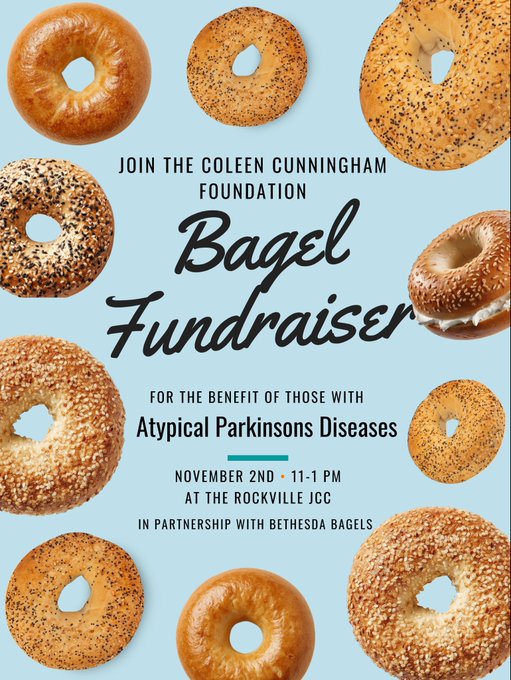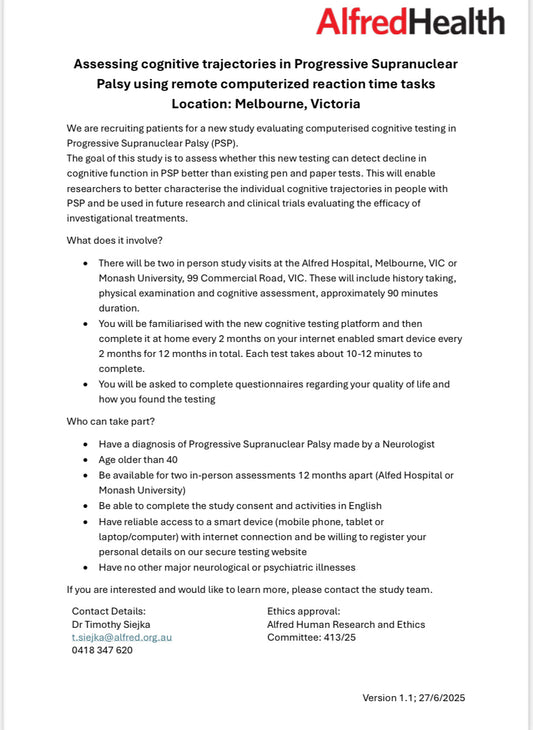It has been said there are four stages, but because there is so little research they are a guideline only.
Many people experience some stage four symptoms at stage one or overlap stages. Some never experience certain symptoms and then others can experience ones not listed. The impact it has on each individual varies dramatically.
Progressive Supranuclear Palsy (PSP) is a rare neurodegenerative disorder that affects movement, balance, vision, speech, and cognitive function. The disease progresses slowly over time, and its symptoms typically become more severe as the disease advances. While not everyone with PSP experiences the same symptoms or progression, there are generally four recognized stages of PSP:
-
Early stage: In the early stage of PSP, individuals may experience symptoms such as difficulty with balance and coordination, changes in gait, and problems with eye movement. These symptoms may be subtle and easily dismissed as normal aging or a different condition.
-
Mid-stage: In the mid-stage of PSP, symptoms become more pronounced and can include falls, speech and swallowing difficulties, and cognitive impairment such as problems with memory and executive function. Depression and apathy are also common.
-
Advanced stage: In the advanced stage of PSP, individuals may become wheelchair-bound and require assistance with daily activities such as eating, dressing, and bathing. Symptoms such as rigidity, spasticity, and involuntary movements become more severe.
-
End-of-life stage: In the end-of-life stage of PSP, individuals may be bedridden and require around-the-clock care. They may have difficulty swallowing, become more susceptible to infections, and experience other complications related to the progression of the disease.
It's important to note that not everyone with PSP will experience all of these stages, and the progression of the disease can vary widely from person to person. Additionally, some individuals may experience rapid progression, while others may experience a slower course of the disease.
Here is the four stages below in more detail;
Early stage:
May present via the fracture clinic, falls services, eye specialist or speech and language therapist. The early stage typically spans years 0-1.
> Ambulant.
> Occasional falls.
> Unsteadiness and poor balance.
> Possible visual problems affecting ability to read.
> Voice changes, for example reduced volume.
> Mood changes.
> Reduced socializing.
> Changes in mood and behavior, including apathy and anxiety.
Mid stage:
Many people reach this stage before diagnosis. Consider discussing advance care planning and advance decisions to refuse treatment. Consider referral to palliative care services. The mid stage typically spans years 2-3.
> Ambulant with aids.
> High risk of falls and injury.
> Visual problems affecting self-care abilities, for example eating and walking as unable to move eyes to see.
> Speech increasingly unintelligible.
> Inability to initiate conversation.
> Impulsivity (risky or impulsive behavior).
> Apathy.
> Dysphagia.
> High level of supervision required.
> Increasingly socially withdrawn.
Advanced stage:
Patients should be on GP palliative care register and have access to specialist palliative care.
The advanced stage typically spans years 3-6.
> Mobility significantly compromised, probably chair bound requiring a wheelchair for mobility.
> Significant visual problems.
> Significant muscle stiffness.
> Significant communication problems, but probably still able to understand.
> High risk of aspiration and pneumonia as a result of dysphagia.
> Pain.
> Increasing periods of sleepiness.
> Incontinence.
> Severely withdrawn socially.
> Dependent for most or all aspects of care.
End of life stage:
This stage is difficult to detect, but may be indicated by reduced levels of consciousness, inability to eat or drink, acute infection, a fall or major fracture, and rapid and significant weight loss. The end of life stage typically spans 6-8 weeks.
> Severe impairments and disabilities.
> Rapid and marked deterioration in condition.
> Decisions with regard to treatment interventions may be required, considering an individual’s previously expressed wishes (advance decisions to refuse treatment).
Discover the Benefits of Vielight Red Light Therapy for Atypical Parkinsonism


 Donate
Donate




131 comments
Oh, Mandy, my heart goes out to you. Navigating the complexities of a diagnosis change, coupled with the emotional and physical challenges it presents, is unimaginably tough. It sounds like both you and your husband have been incredibly strong throughout this journey. Fifty years of marriage is such a testament to the bond you both share. Please know you’re not alone in this journey. I genuinely hope you find the support and resources you need, both for your husband’s care and for your own well-being. Remember, taking care of yourself is also essential. You’re both in my thoughts and prayers. If there are any resources or information you need, please let me know. We’re here for you.
Laura
Oh my gosh, my husband was
Oh my gosh, my husband was
My husband was diagnosed with MSA. For 2 years . Then the diagnosis was changed to PSP. It has been such a heart breaking experience. Very few days go by that I don’t cry a few times. Besides my dad he has been the strongest man I have ever known. In February we will be married 50 years.
No one can seem to help me with stages or where he is in this disease. He can’t get up and down without help, he gets strangled every time he eats or drinks, he is wearing pull-ups full time for about 2-3 weeks! He is 68 and I am 65. I am the primary caregiver and have no other help. I just sometimes need a break. Other than grocery store I rarely leave him. We covet your prayers!
My dad who will be 65 soon, was just diagnosed with PSP a month ago. We have been trying for 3 years to figure out what was wrong with him. The doctors would just keep over medicating him, until we found the right doctors & test. It’s awful, and it’s so hard to see him like this. He falls so much, that I know it’s a matter of time before he really hurts himself. We have had to take everything he loves doing away from him to keep him safe. This disease is awful, and I wouldn’t wish it on my worst enemy. Each day, you can see the changes & heartbreak in his eyes. He wants help so bad, and there’s nothing we can do for him. I just pray, and I ask if you pray, to pray for him too. God is able !!